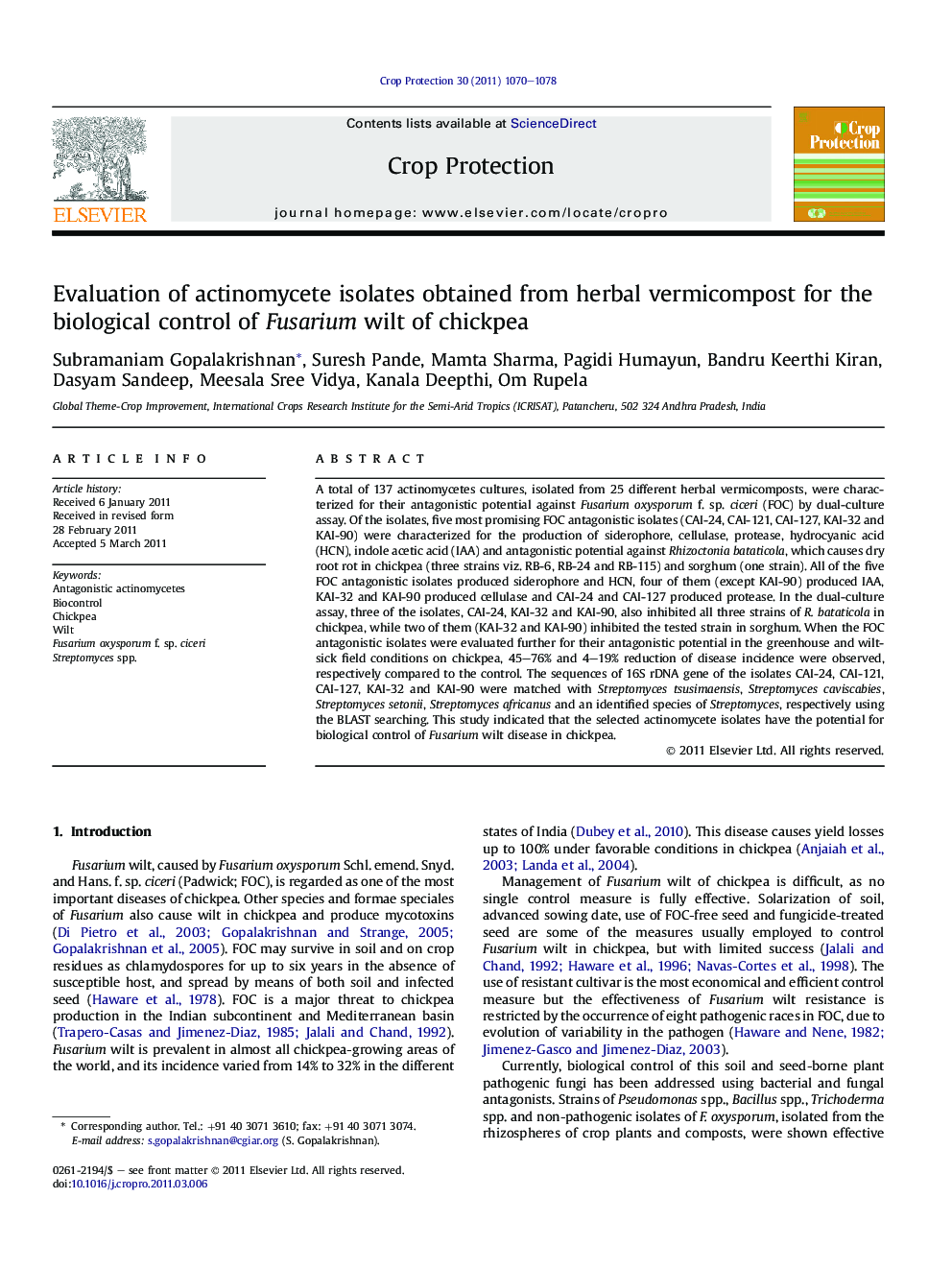| کد مقاله | کد نشریه | سال انتشار | مقاله انگلیسی | نسخه تمام متن |
|---|---|---|---|---|
| 4506772 | 1321328 | 2011 | 9 صفحه PDF | دانلود رایگان |

A total of 137 actinomycetes cultures, isolated from 25 different herbal vermicomposts, were characterized for their antagonistic potential against Fusarium oxysporum f. sp. ciceri (FOC) by dual-culture assay. Of the isolates, five most promising FOC antagonistic isolates (CAI-24, CAI-121, CAI-127, KAI-32 and KAI-90) were characterized for the production of siderophore, cellulase, protease, hydrocyanic acid (HCN), indole acetic acid (IAA) and antagonistic potential against Rhizoctonia bataticola, which causes dry root rot in chickpea (three strains viz. RB-6, RB-24 and RB-115) and sorghum (one strain). All of the five FOC antagonistic isolates produced siderophore and HCN, four of them (except KAI-90) produced IAA, KAI-32 and KAI-90 produced cellulase and CAI-24 and CAI-127 produced protease. In the dual-culture assay, three of the isolates, CAI-24, KAI-32 and KAI-90, also inhibited all three strains of R. bataticola in chickpea, while two of them (KAI-32 and KAI-90) inhibited the tested strain in sorghum. When the FOC antagonistic isolates were evaluated further for their antagonistic potential in the greenhouse and wilt-sick field conditions on chickpea, 45–76% and 4–19% reduction of disease incidence were observed, respectively compared to the control. The sequences of 16S rDNA gene of the isolates CAI-24, CAI-121, CAI-127, KAI-32 and KAI-90 were matched with Streptomyces tsusimaensis, Streptomyces caviscabies, Streptomyces setonii, Streptomyces africanus and an identified species of Streptomyces, respectively using the BLAST searching. This study indicated that the selected actinomycete isolates have the potential for biological control of Fusarium wilt disease in chickpea.
► A total of 137 Actinomycetes, isolated from 25 different herbal vermicomposts, were characterized for their antagonistic potential against Fusarium oxysporum f. sp. ciceri (FOC) by dual-culture assay. Of them, five most promising FOC antagonistic isolates (CAI-24, -121, -127, KAI-32 and -90) were characterized for the production of siderophore, cellulase, protease, hydrocyanic acid (HCN), indole acetic acid (IAA) and antagonistic potential against Macrophomina phaseolina (Rhizoctonia bataticola), which causes dry root rot in chickpea (three strains viz. RB-6, -24 and −115) and sorghum (one strain).
► All the five FOC antagonistic isolates produced siderophore and HCN, four produced IAA (except KAI-90) and two (KAI-32 and -90) produced cellulase and CAI-24 and -127 produced protease.
► In the dual-culture assay, three of the FOC antagonistic isolates, CAI-24, KAI-32 and -90, also inhibited all the three strains of R. bataticola, while two of them inhibited M. phaseolina (KAI-32 and -90). When the FOC antagonistic isolates were evaluated further for their antagonistic potential in the greenhouse and wilt-sick field conditions on chickpea, 45−76% and 4−19% reduction of disease incidence were observed, respectively, over the control.
► The sequences of 16S rDNA gene of the isolates CAI-24, -121, −127, KAI-32 and -90 were matched with Streptomyces tsusimaensis, S. caviscabies, S. setonii, S. africanus and Streptomyces spp., respectively, in the BLAST analysis.
► This study indicated that the selected Actinomycete isolates have the potential for biological control of Fusarium wilt disease in chickpea.
Journal: Crop Protection - Volume 30, Issue 8, August 2011, Pages 1070–1078